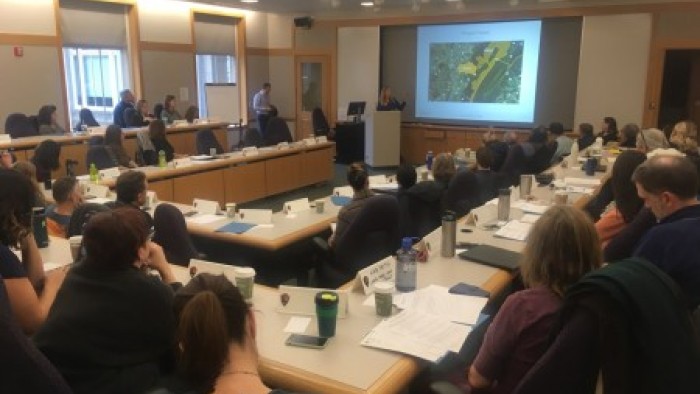How to Bring People Together to Unlock Scaled Conservation Impact

In Brief
Convenings are vital to a field that relies on collaboration.
How, though, can professionals use convenings to spark innovation and help get capital to scale?
A new guide from CFN and the International Land Conservation Network gets at the whens, wheres and hows for this irreplaceable practice.
When we talk about the scale and complexity of intractable social and environmental problems, we are speaking of issues that require collective action. These challenges demand that we step beyond individual mission statements and business models to craft strategies, chart paths forward, and unlock scaled impact—together.
The growth of the conservation finance field is dependent on well-networked communities of practice where people can partner, support, invest in, or otherwise leverage the strength of other individuals and organizations. This is at the heart of the Conservation Finance Network’s efforts, along with our peers and colleagues globally. We need to energize those on the front lines, build shared language, co-develop new and emerging innovations, and replicate success. In other words, we must convene.
Our new guide, “Connect & Mobilize: A Guide to Conservation Finance Convenings,” aggregates the experience and insight of practitioners who have invested deeply in the process of bringing people together across sectors in their respective countries or regions to advance the use of innovative and effective funding and financing strategies.
It emphasizes the importance of convening across sectors—not just conservationists and funders, but a collaborative of practitioners from public agencies, private finance and business, community development nonprofits, academic institutions, and philanthropic entities. It highlights the need to think more creatively and holistically about the co-benefits and who values those outcomes. We share gratitude for the International Land Conservation Network, a project of the Lincoln Institute of Land Policy, for their deep input and support.
By distilling insight on the “who,” “what,” “why,” and “how” of bringing people together, we hope to spur new efforts to partner, support, invest in, or otherwise leverage the strength of others to grow the conservation finance field across countries and regions.
As co-founder of the Conservation Finance Network, Peter Stein offers the foreword to the guide which we share with you here:
When Willie Sutton, an infamous bank robber from the 20th century who was responsible for 30 plus robberies across the United States and was incarcerated off and on for more than 40 years was asked: Why do you rob banks? His cogent reply was: ‘Because that is where the money is’. Conservation finance convenings and field building endeavors are safer and legal compared to robbing banks but produce a similar result: unlocking capital.
I have been a pioneer practitioner in the conservation finance space for more than 4 decades and have witnessed the very rapid and increased global scale of interest by land conservation NGOs, natural resource public agency leaders, philanthropic and private profit seeking private sector players and academics in this emerging field of practice. As both a Co-Founder of the International Land Conservation Network and the Conservation Finance Network, I am pleased that these networks have collaborated to not just produce this guide but have an ongoing relationship that has helped deliver these convenings in Australia, Chile, Canada and soon in Europe and Southern Africa.
Building on the US based CFN’s experience conducting field building conferences, roundtables and regionally focused workshops, boot camps and trainings, plus the robust and broad stakeholder gatherings that continue in Australia under the guidance of Trust for Nature and the Australian Land Conservation Alliance, users of this guide should have a significant advantage in the design and implementation of future conservation finance field building gatherings, and trainings.
While I personally as well as this emerging finance field can be become quite analytical and focus on esoteric elements of financing structures and metrics, it is still dependent on the people who lead organizations and enterprises that form the backbone of the community and are the true innovators and disseminators of practical and scalable solutions.
This guide does highlight a number of those folks who have taken up the mantle of conservation finance and whom I have great confidence in to continue to build the field and expand to communities and any places that may not have access to or all of the resources in place to utilize conservation finance mechanisms. The field is continuing to grow and evolve and I do hope that users of this guide will become an on-going dynamic resource to help build out best practices and expand access to these financing techniques.
Peter Stein
Managing Director, The Lyme Timber Company
Co-founder, The Conservation Finance Network
Steering Committee Member, International Land Conservation Network
This guide’s release is timed ahead of the 3rd Global Congress of the International Land Conservation Network (ILCN) together with the European Land Conservation Network (ELCN) being held virtually December 8-10, 2021. Register here to join.